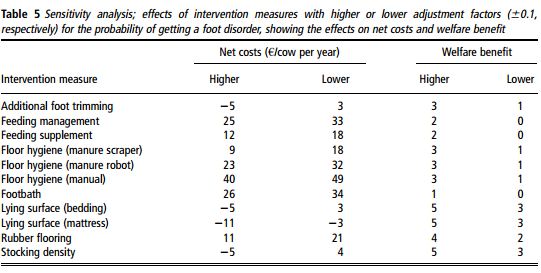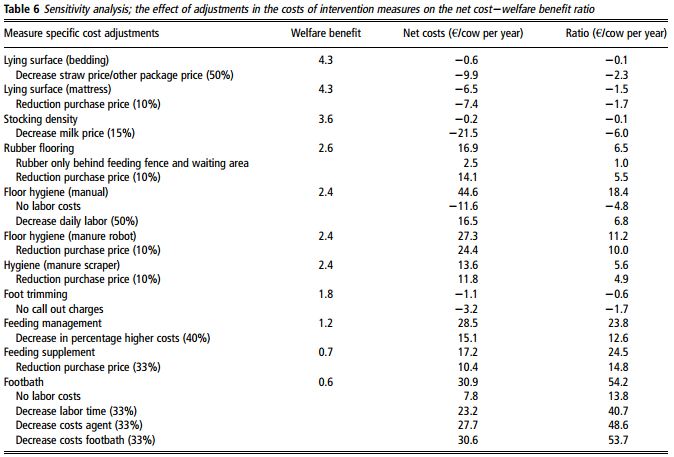



Measures to Improve Dairy Cow Foot Health: Consequences for Farmer Income and Dairy Cow Welfare
A team of Wageningen University researchers analyse what is cost effective in hoof health and prevention.Reducing stocking density, improving lying surface and additional footrimming are all cost effective tools to foot health, according to a Wageningen University study by M R N Bruijnis, H Hogeveen and E N Stassen.
Introduction
In dairy cows, the intensity of metabolic activity, associated with the negative energy balance (NEBAL), is responsible for an increased production of reactive oxygen species (ROS), write the team.
Subsequently, for the development of the condition of oxidative stress, which may overwhelm the antioxidant potential of the bovine maternal organism, making it prone to the development of many puerperal dysfunctions, as well as to an alteration of colostrum and milk quality.
Given these premises, the aims of this study are to evaluate serum and milk concentrations of ROS and lipoperoxides, vitamins A and E, on the 10th, 12th, 14th and 16th day postpartum of dairy cows, a particularly critical period during which the NEBAL reaches its nadir, and to compare the trends of these parameters in two different bovine breeds. The study was performed in pluriparous Italian Friesian and Brown dairy cows.
Literature Review
The literature study showed variable information about the effects of measures to improve dairy cow foot health. First, this is illustrated by the scarce amount of data, which could be derived from literature. As is shown in Table 2, only for a few foot disorders quantitative information is available on the effects of intervention measures. Furthermore, different studies gave ambiguous information about the effects of the measures, for example foot trimming.
Some studies show that foot trimming can be a fruitful measure in preventing foot disorders (Ando et al., 2008), whereas others show that foot trimming can be a risk factor (e.g. Amory et al., 2006). The latter can be explained by the fact that foot trimming can be applied when there are problems with foot health already.
Farmers experience this diversity of reported effects in different, and sometimes contradicting, advices.
This does not support the farmers in taking real action and to implement the measures properly.
From the selected measures only a few were cost-effective in the default calculation: improving lying surface with a mattress (h7/cow per year) or bedding (h1/cow per year), foot trimming (h1/cow per year) or reduce stocking density (h0/cow per year).
Furthermore, the range of costs to implement the measures was large: h7/cow per year for additional foot trimming and h56/cow per year for manual cleaning of the ?oor. The bene?ts contrasting these costs vary as well. Some rather costly measures, like improved feeding, have low bene?ts, making the measure less interesting compared with, for example, rubber ?ooring where the investment is compensated by relative high economic and welfare bene?t.
An argument that makes the measures of feed improvement more interesting is the fact that these measures are easy to implement without a big investment, labor effort or routine adjustment. Because such factors are important when choosing between possible intervention measures (Huijps et al., 2009), improving feed compositionc still can be an interesting measure for certain farmers.
The sensitivity analysis showed the variability of the effects as estimated in the default calculation.
The adjustments of the probabilities to get a foot disorder can make a difference for being cost effective or not, as is the case for stocking density or the use of bedding. The model used in this study is adjustable and can be used to model new ?ndings, ideas or developments. For example, the effects of including a ‘comfort-effect’ of intervention measures can be evaluated. Some measures do not only increase welfare by preventing new foot disorders, but also by reducing impact severity (without necessarily reducing the occurrence of foot Table 6 Sensitivity analysis; the effect of adjustments in the costs of intervention measures on the net cost2welfare bene?t ratio.
Conclusion
Present study gives insight into the costs and bene?ts of different intervention measures to improve dairy cow foot health. The following intervention measures are cost-effective in our default calculation: improve lying surface (mattress and bedding, h7 and h1/cow per year, respectively), reduce stocking density (break even) and performing additional foot trimming (h1/cow per year). These measures have a relative high welfare bene?t as well.
The priority setting can be different for speci?c circumstances (e.g. a different default situation with overstocking and/or no foot trimming at all). The prioritization can also change due to different assumptions about the measures or by different ways of executing a measure.
The cost-effectiveness of labor-intensive measures, for example, is affected by the amount of labor and the value given to labor.




